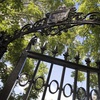{shortcode-605444087b1044c8e6726ed711d97c364b5b548a}
The year 2005 was a landmark moment for cinema and an unforgettable year for Star Wars fans with the release of “Star Wars: Episode III — Revenge of the Sith.” Directed by George Lucas, the film brought a powerful close to the prequel trilogy, telling the inevitable and tragic story of Anakin Skywalker’s descent to the Dark Side. Starring Hayden Christensen as Jedi Knight Anakin Skywalker, Ewan McGregor as Obi-Wan Kenobi, and Harvard alumna Natalie Portman ’03 as Padmé Amidala, “Revenge of the Sith” cemented itself as a crucial and beloved chapter in the Star Wars saga. In honor of its 20 year anniversary, the film has been re-released in theaters, and fans may finally be able to appreciate it, especially as far as its leading actor is concerned.
“Revenge of the Sith” follows the harrowing fall of Anakin. Set against the backdrop of the collapsing Republic and the rise of the Galactic Empire, the film explores Anakin’s inner fear and anger as he experiences haunting visions of losing his wife, Padmé, in childbirth. Manipulated by Chancellor Palpatine (Ian McDiarmid), who is secretly Sith Lord Darth Sidious, Anakin ultimately betrays the Jedi Order. His former mentor and friend, Obi-Wan, confronts him in a heart wrenching lightsaber duel, which Anakin loses terribly. The film closes with Padmé’s tragic foreshadowed death after giving birth to twins Luke and Leia Skywalker, and Anakin’s transformation into the masked figure of Darth Vader, setting the stage for the original Star Wars trilogy.
Despite its significance to the “Star Wars” franchise, “Revenge of the Sith” was not universally praised upon release. Audiences in particular were very critical of Christensen’s portrayal of Anakin. Many derided his performance as wooden or overly melodramatic, unable to look past the occasionally clunky, awkward dialogue. Fans had also placed overwhelmingly high expectations on him. Instead of criticizing the writers for horrible, bland lines, fans seemed to push all the blame onto Christensen. The harsh criticisms marred Christensen’s career, prompting him to retreat from Hollywood’s spotlight in the 2010s.
However, a new generation of fans, many of whom grew up with the prequels as their introduction to the Star Wars franchise, now view the films and Christensen’s performance with great admiration and affection. Where once there was scorn, there is now appreciation for his portrayal of tormented Anakin, caught between loyalty to the Jedi Order, his love for his wife, and ambitions. Especially with the 20th anniversary of “Revenge of the Sith,” Christensen has recently been honored in a way he hadn’t been two decades before. He has been spotted visiting screenings of the movie in theaters in Los Angeles, alongside his costar Samuel L. Jackson, who played Mace Windu.
Although the film’s dialogue can get weak at times, much of its enduring appeal seems to lie in its quotable moments. One of the most iconic dialogue exchanges is Obi-Wan’s confrontation with Anakin at Mustafar — a battle that cements Anakin’s transformation into Darth Vader. Despite the exhilarating lightsaber battle sequence, it is surprising that the Battle does not have a more iconic name, like the Duel of Fates in “Star Wars: Episode I — The Phantom Menace.” McGregor’s heart wrenching cry, “You were the Chosen One!” and Christensen’s cold retort, “If you’re not with me, you are my enemy,” remains permanently etched in the memories of fans worldwide.
Still, the film is not without its narrative flaws. Some moments unfold with a convenience that strains believability, such as the opening scene of the movie. Anakin and Obi-Wan pilot a starfighter craft to raid General Grievous’ (Matthew Wood) ship in order to rescue Chancellor Palpatine. The two characters proceed to Palpatine’s prison cell with relatively little resistance, except for a close call in the elevator shaft. The ease with which this mission is accomplished, given the supposed stakes, feels stupidly convenient. Even more baffling is the swiftness with which Anakin turns to the Dark Side. It seems surprisingly convenient that after a few dreams about his wife, Padmé, dying in childbirth, and one convincing speech from Palpatine, he is easily enticed to leave the Jedi Order and join the Dark Side. This pivotal transformation feels rushed for a character destined to become one of cinema’s most notorious villains, Darth Vader.
Nevertheless, the movie is still beloved by many “Star Wars” fans. For those who grew up with it, the film evokes a strong sense of nostalgia. Within the broader “Star Wars” franchise, “Revenge of the Sith” serves as the keystone that binds the prequel to the original trilogy. It provides the emotional weight behind Darth Vader’s terrifying presence in “Star Wars: Episode IV — A New Hope” and offers crucial context for his redemption arc that follows.
Today, the Star Wars franchise has grown immensely, with new films and spin-off shows — although many fans prefer to forget the existence of the sequel trilogy due to storytelling and character inconsistencies. Christensen’s return as Anakin Skywalker in spin-off show “Ahsoka” has been met with overwhelming enthusiasm and extensive fan support, a far cry from what he experienced when “Episode II” and “Episode III” were released.
As the 20th anniversary celebrations of “Episode III — Revenge of the Sith” continue, it is clear that both the film and Hayden Christensen have found their rightful place in the history of the Star Wars franchise, and are finally getting the recognition and love from fans that they deserve.
—Staff writer Anastasia Poliakova can be reached at anastasia.poliakova@thecrimson.com.













